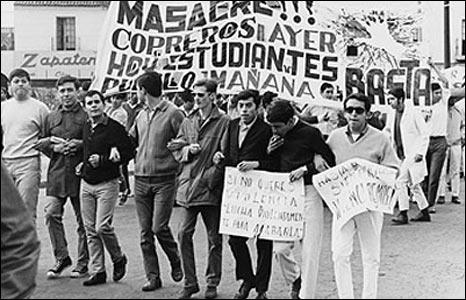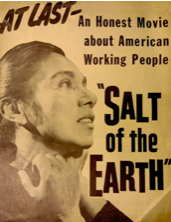The 1960’s was a decade that will go down in history, from the music to the civil rights movement and the cold war. By far this decade was definitely not a boring one, and the year 1968 was no different, and in many ways some of the most influential events in the 1960’s took place in the year 1968. 1968 is a famous year in history that will never be forgotten. The sheer number of historical events that took place is in abundance, from the assassination of Martin Luther King Jr. on April 4 and that of Robert F. Kennedy on June 6, to October 11, 1968 and the first Manned Apollo Mission. 1968 is forever a year that will remain fresh in our minds. However, there are events that took place in Mexico during 1968 that are often over looked, and unfortunately somewhat forgotten. During the 1960’s in the United States student-lead protests and movements were common, especially when students noticed injustices, and Mexican students were no different.

| Courtesy of The Yucatan Times | October 2, 1968
Picture a hot summer day in Mexico. All is calm, the country is organizing the hosting of the 1968 Olympics, and all is well in the world. That is until trouble broke out on July 22, 1968. On July 22, two rival high schools broke out into a full on brawl. It remains a mystery today as to what sparked this disagreement that ultimately led to so many unfortunate events. The fighting is rumored to have been between two rival gangs in the city.1 However, this has not been confirmed. The fighting grew with intensity and aggression. The fighting became so intense that the police were called in to restore order. The police who arrived were not the type to let people off with a warning. The police who arrived at the scene were police who act as another branch of the military. The group of officers who arrived at the scene were sent as a form of riot control, which are meant to deescalate dangerous or extreme situations and restore peace. When the police arrived, they were prepared to take out anyone in their path who interfered with their restoring the peace. However, peace was the last thing that occurred when the police arrived. When the police arrived any students in the near vicinity were met with violence and many were arrested on sight. This included students and teachers. People were chased by the police off campus grounds and were followed into nearby neighborhoods, where they were beaten and arrested. The result of this student–police conflict was that many were wounded, an even greater number were arrested, and unfortunately some lost their lives due to the brutality of the situation. The injustice and gravity of these events then sparked the movement for college students to assemble and band together to begin protesting the government and its actions and the role they played in the violence. Due to the brutality that the students were met with, this then allowed the Mexican people to resonate with the cause and lead them to come together and oppose the injustice the government was responsible for. On July 26, 1968 Mexico had its largest protest for its time. The goal of this protest was to achieve compensation for those injured and for the families of the dead, as well as the removal of the chief and deputy chief of police at the time.2 However, the Mexican government had different ideas as to how to handle the situation at hand.

In the year 1968, Mexico was set to host the Olympics, and during this time, Mexico was in the limelight and therefore one of the Government’s main focuses was on maintaining a united and peaceful front to the outside world. The government then took into account the events that had been taking place in the rest of the world that year, especially the student-led protests that were happening in the United States as well as in many European countries, and all the issues this was causing for the Unites States government as well as the European governments with the same issues. Worried that these student protests would bring negative and unnecessary attention on Mexico, the Mexican government decided to take this matter into its own hands. During the march on July 26, the peaceful protesters were cut off by soldiers who were planted in downtown Mexico City. Just when the protesters arrived in downtown Mexico City, people posing as protesters began to grab rocks that were planted in the trash cans there, which was very out of character for the city or for almost any city for that matter.3 With rocks in hand, the alleged protesters began to throw rocks at the soldiers on site, therefore escalating the situation dramatically. Due to this aggression, for the following three days the city was in a state of unrest. The city was overcome by violence and aggression, which seemed to stem from the aggression of the Mexican soldiers and “alleged protesters.” Following these three days of unrest, the people of Mexico still felt a need to combat all this unnecessary aggression instigated by the Mexican government. These protests continued until the fateful day of October 2, 1968.
On the eve of the 1968 Mexican Olympics, the Mexican government was becoming more and more concerned with the state of unrest that was occurring in Mexico City as well as throughout the rest of the country. Determined to put an end to this issue, the government decided to stop the protests at the root of the problem. On October 2, 1968, the protesters were meeting at the Plaza near the Edficio Chihuahua in downtown Mexico City in an informational session to plan their next protesting demonstration. The government then discovered their plan for the protesters to meet at the plaza of Tres Culturas in downtown Mexico City. The meeting for the protesters was set to begin at 4:00 pm, yet the police began to limit the amount of access to downtown at 3:00 pm.4 Despite this being a small number of people compared to the previous protests, approximately five thousand people were still in attendance. The police then enclosed the Plaza de Tres Culturas and began attacking the people in the plaza. The people were met with automatic weapons and were told to get on the ground. Despite getting on the ground, the people were still beaten and met with acts of aggression. This lasted approximately two hours. According to some sources it is said that the bodies were in piles all throughout the plaza. Unfortunately, there is not an exact death count of the massacre that occurred at the Plaza de Tres Culturas, due to the fact that the Mexican government controlled what the news outlets were able to broadcast. The massacre and its gravity were significantly down played.5 On October 3, 1968 Mexican news outlets were broadcasting the event as though only twenty-nine people died, whereas other sources estimate as many as two-hundred deaths.6 Unfortunately the exact number of deaths due to the events which took place on October 2, 1968 still remains a mystery.

With the lack of recognition from the government and the news outlets as to the massacre that occurred on October 2, 1968 in Mexico City, many people who were there felt that it was their duty to report and take record of the events that happened to ensure that this injustice would never be forgotten. Thus this is how the massacre that occurred on October 2, 1968 in Mexico City became known as La Nueva Noche Triste.7 The authors who are considered to have contributed the most to this literary movement are Octavio Paz and Carlos Fuentes, as they both commented on the events for its historical value as well as an outlet to call attention to the injustices that were occurring at the hands of the Mexican government.8 With the start of this literary movement, it gave people the opportunity to offer criticisms on the government and their actions in a more creative setting and ultimately allowed La Nueva Noche Triste to never be forgotten.
Unfortunately, we cannot say today that due to these protests in Mexico during 1968 that the Mexican government is completely reformed. However, we can say that since the events that occurred in Mexico, the Mexican government has not repeated these large-scale heavy-handed tactics on its people. Also, due to these events and the writing that stemmed from these events, a new dialogue between literature and history has emerged, which has given people a bridge between these two different areas. Overall, the goals of the protesters were never reached. However, their efforts were not wasted. The Mexican government now somewhat treats its people with more respect, and often thinks twice before acting in such ways. The literary movement which grew from the ashes of La Nueva Noche Triste allows two different disciplines to grow together and provide a different perspective on the events which took place. When looking back on the 1960’s and all the historical events that occurred, it is important to remember not just the events which took place in the United States or in Prague or in Paris, but it is also important to remember the events that took place in Mexico as well, especially the events which took place during 1968 in Mexico.
- Mark Kurlansky, The Year that Rocked the World (New York:The Random House Publishing Group, 2004), 321-322. ↵
- Mark Kurlansky, The Year that Rocked the World (New York:The Random House Publishing Group, 2004), 322-323. ↵
- Mark Kurlansky, The Year that Rocked the World (New York: The Random House Publishing Group, 2004), 323-325. ↵
- Mark Kurlansky, The Year that Rocked the World (New York: The Random House Publishing Group, 2004), 323-325. ↵
- Claire Brewster, “The Student Movement of 1968 and The Mexican Press: The Cases of Excealsior and Siempre!,” Bulletin of Latin American Research 21, no. 2 (2002): 172-173. ↵
- Sam Dillion, “A General Illuminates ’68 Massacre In Mexico,” New York Times , (June 28, 1999). Accessed 24 2018.http://www.nytimes.com/1999/06/29/world/a-general-illuminates-68-massacre-in-mexico.html?register=google. ↵
- Victoria Carpenter, “Tlatelolco 1968 in Contemporary Mexican Literature Introduction,” Bulletin of Latin American Reaserch 24, no. 4 (2005): 71-72. ↵
- Victoria Carpenter, “Tlatelolco 1968 in Contemporary Mexican Literature Introduction,” Bulletin of Latin American Research 24, no. 4 (2005): 73-74. ↵



50 comments
Rylie Kieny
It’s sad that I have never heard of this event. Its tragic and deserves to be shared. It is sad that a government would believe fighting fire with fire would ever be a good idea. We as citizens put our trust in our government to keep us safe, not add to the problem. It’s also wrong that the government controls all the information and therefor an accurate account of the event was not recorded. However this event was not in vain. It is upsetting it had to come to these lengths but it was a way to highlight the flaws in the Mexican government. No system is perfect but we must always hold them to the highest of standards and expectations.
Gabriela Ochoa
I had never heard of La Nueva Noche Triste before but after reading this article it made me realize more things that the Mexican government has done to hurt its people. its amazing that such a small protest was taken out of hand and so much violence was used to stop it. I wasn’t surprised to read that this was covered up like many things are now a days in Mexico. I am glad however that the students and the other protestors story was eventually told and people are able to honor them and what they did.
Christopher Hohman
Nice article. We have talked a little about the year 1968 in my class, but I did not know about this event. It is terrible what the Mexican government did to its own people. To squash their right to protest and to kill its own citizens. That is just terrible. It also sounds like the government is quite authoritarian. They decided what was shown on TV and when and they manipulated the facts and figures to down play the damage. That is crazy. It seems like some countries that host the Olympics do not really deserve to.
Alexis Martinez
I had never heard of La Nueva Noche Triste but after reading this article it breaks my heart to read about the brutality these people faced. However, I find it so inspiring that these people came together as one to fight for what they believed in despite the harshness they faced by police and their government. It was scary to read about how much control the government had and really made me think about how things are here in the U.S.
Daniela Martinez
Ive never heard of this incident before. The article was informative and well written. I always like reading stories in which students are the main protagonist or are fighting for a common cause. As someone who is Mexican, it saddens me to think that this event was covered by the government to the point where the incident is unknown to the general public. Events like these are exactly what makes Mexican citizens mistrust the very people who are supposed to protect them on a daily basis. Mexicos police have long been invaded by corruption and even now something must be done.
Andrea Cabrera
Mexican and most Latin-American people are unable to rely on their government to keep them safe. I’m disappointed that police officers hurt their own people when they try to peacefully protest for their own ideals just because they differ with what the government believes. Fighting fire with fire creates more disaster. The article did a great job in showing how these protesters were mistreated, it was also enlightening to see how the people of Mexico responded to the event and shows awareness to Americans about how corrupt other countries can get.
Daniela Cardona
It’s sad to think I had never even heard of La Nueva Noche Triste. I do understand, however, that a large part of the reason for this is the Mexican governments tendency to keep certain things private. It is sad to hear how brutally the government treated its people that night, and scary to know how much power they have. I liked how the author placed emphasis on a different country that is so close to us, yet gets commonly overlooked especially when we have a lot going on.
Richard Morales
I am amazed to have never heard of this event. It is crazy that the Mexican government had enough power to completely cover up a whole massacre. This was a terrible event, I have never heard of anything like that. It makes me thankful to be an American with the right to protest freely. It is ashamed to hear about numerous students losing their lives to stand up for what they believed in.
Sienna Guerra
I have always believed that this world can never be united unless a tragedy or disaster occurs that brings a community of people back together. I find it amazing on how the students of this community never got along with each other until they were being assaulted by the police. I love how they came together as a unit in order to fight against them. Protest and rallies are effective until they come to a point like this one.
Taylor Rech
I read a similar article just the other day about an earthquake that killed many Mexicans; this is another example of the Mexican government acting inappropriately during a time of crisis. Governments are meant to help the country socially as well as economically and in foreign interactions, so I find it sad that the Mexican people are unable to rely on their government to help them when the country needs help the most. I hope that the government can continue to reform so that the people of Mexico can live in peace with the comfort that their government is there to help them not harm or restrict them.